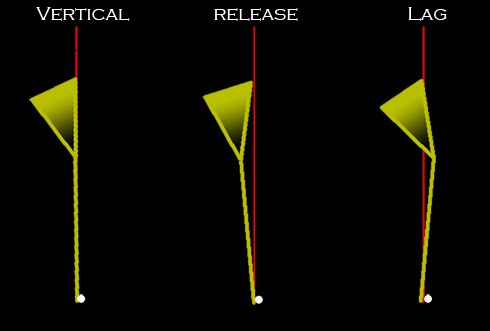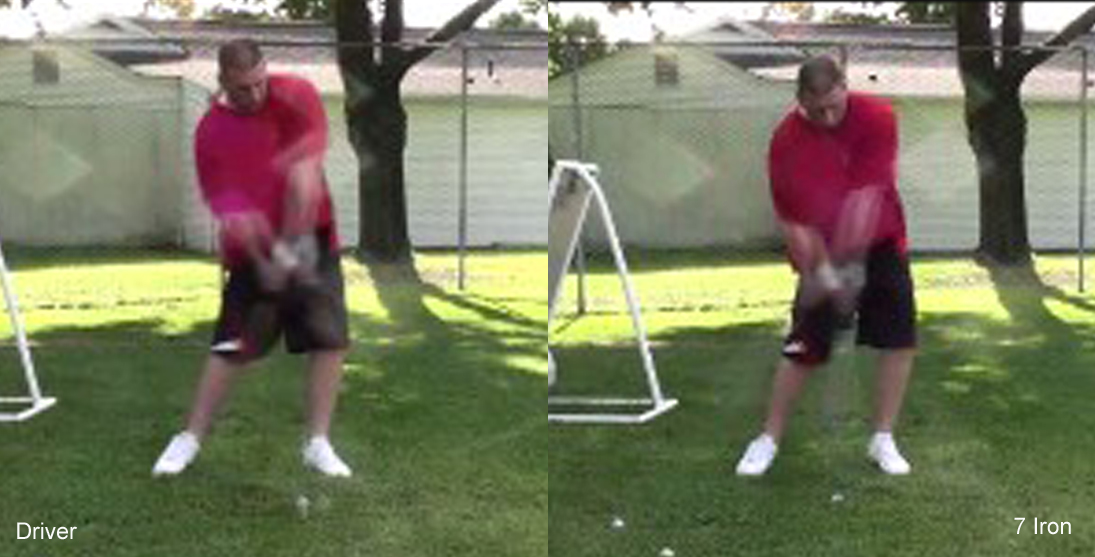 Frank Razzaia is a 4.0 index golfer hoping to build a more reliable, tournament ready swing. At normal speed, I am a big fan of Frank’s swing. However, watch his swing frame by frame and you will notice he lacks one of the most important attributes in golf: lag.
Frank Razzaia is a 4.0 index golfer hoping to build a more reliable, tournament ready swing. At normal speed, I am a big fan of Frank’s swing. However, watch his swing frame by frame and you will notice he lacks one of the most important attributes in golf: lag.
Read on to see Frank’s swing and the fixes I’ve outlined for him.
The Swing
Frank’s swing can be seen here as a QuickTime movie. This shows the down-the-line and face-on angles with his driver and 6-iron. I would recommend that you to watch the video, identify what you think is his root problem, and read on.
Lag
Lag. Just say the word and amateur golfers immediately perk up as if this concept is the “secret” to a better game. Just to be clear, let’s address what lag is and then address Frank’s swing with lag in mind.
What is Lag?

This diagram should look familiar but it is the easiest way for me to illustrate what lag is. While this is somewhat of a simplification, there are essentially three different impact positions.
- Vertical (0° of lag) – For a swing that has a vertical impact, which is common among both tour pros and good amateurs, the shaft of the club overlaps with the vertical line drawn through the backside of the golf ball. This means at impact, the loft of the club has no change.
- Release (negative lag) – For a swing with a release, which is common among mid- to high-handicappers, the shaft of the club is angled away from the target at impact. This means that the player is adding loft to the club at impact.
- Lag – For a swing that has lag, the shaft of the club is angled towards the target at impact. This means that the player is delofting the club at impact.
Lag is important because it maximizes acceleration and helps create an optimal launch angle for every club in your bag.
Frank’s Lag
As stated above, Frank has what most people would consider an excellent swing. Of course there are improvements that could be made to various parts of his swing but the fact that he is not generating lag is surprising. Take a look at the two frames below.

With Frank’s swing speed he should have 3-4 degrees of lag with his driver and 9-10 degrees of lag with his 7-iron. Unfortunately, Frank appears to have approximately -4° (that’s negative four) of lag with his driver and virtually the same position with his 7-iron. This means that Frank is unnecessarily adding loft to his clubs AND is negatively affecting his acceleration.
Potential Fixes
Generally speaking, there are two approaches to creating lag. One approach is to view lag as a byproduct. Basically, think of lag as the result of many fundamentals of your swing working together to generate the proper impact position. Thus, rather than working on lag, identify the component(s) that prevent you from achieving the proper impact position and allow your lag to naturally improve. The second approach to lag is to view it as a starting point. This assumes that by focusing on lag other components of your swing will naturally improve.
Despite the fact that I have a problem with Frank’s ball position with his irons, Frank’s swing has enough solid components to generate lag. So while I would normally recommend working on other fundamentals to achieve lag, I asked Frank to focus on lag directly. While there are a number of other drills that could help Frank, in order to guarantee that his practice is effective, I gave Frank my favorite drill: the lag stick.
Lag Stick
The lag stick will give you immediate feedback, painfully reminding you do not have proper lag or a extension. Because this is the first time that I have recommended this drill on The Sand Trap I want to go through how to make it and then how to properly use it. An example of a player using the lag stick can be seen here as a QuickTime movie. This shows the overhead view of me using the lag stick in 2000.
Components
- 1 Bicycle Safety Flag
- 1 Roll of Masking Tape
- 1 Measuring Tape
- 1 Saw (Hand or Table)
How to Make
The most important component of this drill is the bicycle safety stick. There are alternatives that you can use but these sticks are meant to be flexible yet strong – ideal for impact with your body. Once you have the stick, measure and mark from the tip of the stick without the flag 3′ 6.” Next, wrap the mark with masking tape going around no less than 5 times. Then cut with a saw in the middle of the masking tape. Note that if you do not use masking tape before you cut, the stick is going to splinter. Last, although this is not necessary, you may want to place a plastic cap on the end of the side of the stick you just cut or wrap and secure the end of the stick with some kind of fabric.
How to Use
Stick the pointed end of the lag stick through the small hole in the end of your grip. The first time that you do this with any of your clubs it will be difficult to pierce the double sided tape that keeps your grip in place. After the first time though it becomes much easier. Once you have the stick int the club, set up to the golf ball with the stick in place. Adjust the stick so that only two to three inches of it are pressing against your leading hip. With your normal set up, the stick will be bent towards your leading hip. Now swing. The lag stick will let you know quickly whether or not you have proper lag or extension.
Warning!!!
This drill can be very painful. I would recommend starting with slow short swings and begin to speed up and lengthen your swing as you get better with this drill. If you are finding yourself in too much pain, DO NOT CONTINUE.
Time Line: This drill will literally force you to create lag. Frankly, after the first few times wacking yourself in the hip you will start to make adjustments either consciously or subconsciously. If you start with your SW and the work your way back in your swing you will notice improvements rather quickly.
Be sure to monitor… your swing plane. Many golfers try to “cheat” the lag stick by coming over the top. While it is fun to record your lag face-on, the down-the-line camera angle is more helpful. Use the lag stick to enforce good lag and video to enforce a good swing plane. If you can do both, you’ll know you are on the right track.
Conclusion
Frank is an excellent golfer with a swing that many of us should envy. However, improving his impact position could make him a better, more consistent golfer. No doubt, this is an incredibly difficult change to make but if he works hard with his lag stick I am willing to bet that he will be happy with the results.
Your Turn!
If you’re interested in having your swing analyzed in a future edition of Swing Check here on The Sand Trap, check out the requirements page and submit your videos today!
I don’t doubt that Frank could improve on his lag but watching his video he has very poor footwork and weight transfer.
There’s very little weight transfer on his back swing robbing him of potential distance. His left knee barely comes inward toward his right knee as he finishes his backswing.
His poor weight shift also may effect him not quite finishing his backswing, again robbing him of power.
I think if you can improve his lag and his footwork/weight transfer, Frank should be able to crush the ball.
Good Luck!
Parker
I would tend to disagree with your statement about his footwork. While an older generation of players like Byron Nelson and Jack Nicklaus did allow their knees to come inward, the modern golf swing increases muscle tension by restricting the left legs movement. Take a look at players like Duval in 99 or Tiger’s new swing to see what I mean. Hope that helps.
I’m no expert, but I would say that Frank rushes into the downswing and doesn’t have a very committed weight transfer. The whole swing seems to be designed for accuracy. (Not much time for things to get too out of alignment.) I would wager that Frank is fairly accurate but struggles greatly in the distance department. If he were to allow the club to finish the back swing while initiating the down swing with his hips/weight transfer, lag would be created without having to do anything exotic.
My 2 Cents. Good write up though and an interesting device.
T.M.
Yes I understand that the modern swing has changed with more of a roll with the front foot than a lifting of the heel. It just apears to me that Frank is a little flat footed in his backswing, thats all. As I stated before I think he could transfer a little more weight during his backswing just as Richard percieved and this would naturaly make his front foot roll back towards his back foot.
Just my 2 Cents 🙂
Roll, lift, whatever…a lot of modern players do a lot of nothing with the left foot. But that is only for people who are flexible enough to complete the shoulder turn with the feet planted, i.e., not this guy.
I want to build a lagstick – just to confirm how to use it… At address is it supposed to contact the outside of your left hip? ( for a righty). Is there a video anywhere of someone actually practicing with it?
Like the one linked to in the article above?